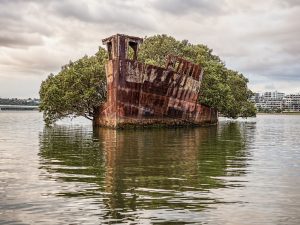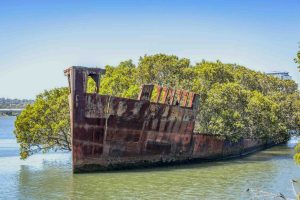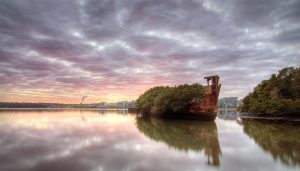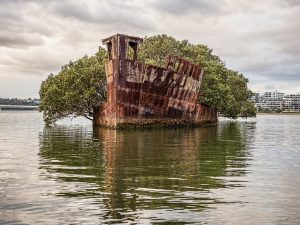In a serene corner of Homebush Bay, just west of Sydney, Australia, lies a unique testament to nature’s resilience and creativity: the SS Ayrfield. Once a sturdy vessel that navigated the waters of the Pacific, the SS Ayrfield now stands as an awe-inspiring symbol of nature’s reclaiming power, transforming from a rusting hulk into a captivating floating forest. This phenomenon has drawn curious travelers, photographers, and nature enthusiasts from around the world, all eager to witness this enchanting fusion of man-made and natural worlds.

## The Storied Past of the SS Ayrfield
The SS Ayrfield was built in 1911 in the United Kingdom and originally named the SS Corrimal. During its early years, it served as a coal-carrying steamship, traversing the oceans to support various industries. During World War II, the ship played a critical role as a supply vessel for American troops stationed in the Pacific, reflecting its robust construction and reliable performance.

After the war, the vessel was repurposed for civilian use and renamed the SS Ayrfield. It operated as a transport ship, ferrying supplies between Newcastle and Sydney. However, as the years rolled on and technology advanced, the SS Ayrfield, like many of its contemporaries, faced obsolescence. By 1972, it was decommissioned and sent to Homebush Bay, a location designated for the dismantling of old ships.
## The Birth of a Floating Forest
The SS Ayrfield’s journey to becoming a floating forest began with its abandonment. Left to rust and decay, the ship might have been forgotten if not for the remarkable transformation that took place over the decades. Nature, undeterred by the vessel’s metallic structure, began to reclaim it in a truly magical way.

Trees and shrubs took root in the ship’s hull, thriving in the unique conditions provided by the decaying metal and accumulated silt. The hull, once a barrier against the elements, now cradled the burgeoning forest, offering protection and nutrients. Rainwater collected in the crevices, and birds contributed to the spread of seeds. Slowly but surely, the SS Ayrfield was enveloped in a verdant canopy, its decks and beams becoming home to a vibrant ecosystem.
## A Haven for Flora and Fauna
Today, the SS Ayrfield is a haven for both flora and fauna. The trees, predominantly mangroves, have grown tall and lush, their roots intertwining with the ship’s rusty framework. These resilient plants thrive in the brackish waters of Homebush Bay, their presence a testament to nature’s adaptability.
The floating forest has also become a sanctuary for various bird species and marine life. Birds nest in the trees and on the ship’s superstructure, while fish and other aquatic creatures find shelter among the submerged parts of the hull. The SS Ayrfield is a living, breathing example of how nature can flourish even in the most unexpected places.
## A Photographer’s Dream
For photographers, the SS Ayrfield is an irresistible subject. The juxtaposition of rusting metal and lush greenery creates a striking visual contrast, especially when bathed in the golden hues of dawn or dusk. The reflection of the ship and its forest in the calm waters of the bay adds to the ethereal beauty, making it a popular spot for capturing nature’s reclamation of man-made structures.
Many photographers have documented the SS Ayrfield over the years, each capturing a unique perspective of its transformation. Whether seen from the shore or approached by kayak, the floating forest presents a compelling and ever-changing scene that continues to captivate all who behold it.
## The Symbolism of the SS Ayrfield
Beyond its visual appeal, the SS Ayrfield stands as a powerful symbol of nature’s resilience and renewal. It serves as a reminder that, given time, nature can reclaim and restore even the most neglected and industrialized environments. The ship’s transformation into a floating forest underscores the importance of respecting and preserving our natural world.
In an era where environmental concerns are at the forefront, the SS Ayrfield inspires hope. It demonstrates that nature, when allowed to take its course, can heal and thrive, even in the aftermath of human intervention. This floating forest is not just a curiosity; it is a testament to the enduring power of nature to find beauty and life in the most unlikely of places.
## Visiting the SS Ayrfield
If you’re planning a visit to see the SS Ayrfield, there are a few things to keep in mind. The ship is located in Homebush Bay, which is accessible from Sydney by public transport or car. The best views are from the shore, particularly during sunrise or sunset, when the light casts a magical glow over the scene.
For those looking to get closer, kayaking offers a unique perspective. Paddling around the ship allows you to appreciate the intricate details of the forest and the ship’s structure up close. However, be mindful of the tides and weather conditions, and ensure you follow local regulations and safety guidelines
The SS Ayrfield’s transformation into a floating forest is a remarkable story of nature’s ability to reclaim and rejuvenate. This abandoned vessel, once a symbol of industrial might, now stands as a testament to the quiet, persistent power of the natural world. Whether you’re a photographer, a nature lover, or simply someone who appreciates the unexpected beauty in the world, the SS Ayrfield is a must-see marvel.

